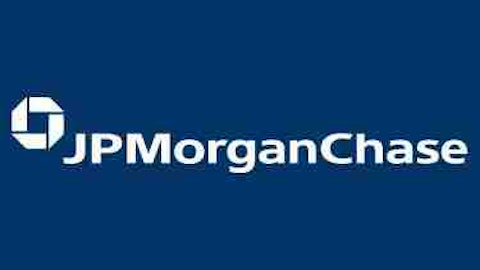JPMorgan Chase & Co. (NYSE:JPM) is taking an aggressive stand in Africa. America’s largest bank, with regard to asset size, has made inroads in Africa as it tries to tap into a market that many other multinational corporations are already exploiting.
Kenya’s Business Daily, the financial services newspaper for Nation Media Group, East and Central Africa’s largest media house, reports that JPMorgan Chase & Co. (NYSE:JPM) has been given approval to open a representative office by the Central Bank of Kenya. The CBK, in a statement on bank supervision last week, stated “The applicants had been granted approval-in-principle by the end of 2012, and processing for final authorization was at an advanced stage.”
The UK bank, HSBC Holdings plc (ADR) (NYSE:HBC), set base in Kenya in 2011. JPMorgan Chase & Co. (NYSE:JPM), on the other hand, also operates offices in Nigeria and South Africa. From its website, JPMorgan states its business portfolio in Africa includes asset management, investment banking, private banking, treasury and securities services, and global corporate banking. In the first quarter of 2013, the company’s private bank and asset management divisions raised $737 million in profits against $2.4 billion in revenue. Evidently, these are portfolios the company plan to cash in on immensely.
JPMorgan African services further include but are not limited to “Leveraging the capital strength of JPMorgan Chase & Co. (NYSE:JPM) and extend credit to help clients grow their business.” This will be vital, if not the core, of its business model in Africa. African banks are facing tough competition with regard to big project and large infrastructure financing. Relatively low capital bases and regulatory hitches consistently block local African banks from being able to lend to large multi-million dollar projects. In Kenya, for instance, the Business Daily notes that CBK regulations bar Kenyan banks from lending to a single borrower up to 25% of their core capital. Kenya Commercial Bank, Kenya’s largest bank, can only lend a maximum of $125 million. The situation should be grimmer in many other African countries.
The wide berth for huge-potential retail banking
The Economist reports that, due to low infiltration rates, Africa holds a multi-million dollar potential for retail banking investments. The multinationals, however, have a different agenda in mind. According to a 2011 World Bank survey, across sub-Saharan Africa, only about a quarter of adults have accounts at formal financial institutions. Mauritius led with the percentage of the population 15 years and over holding an account being 15. South Africa and Kenya came second and third, respectively at 52% and 44%. But, figures for the rest of Africa are predominantly single-digits.
Yet, JPMorgan Chase & Co. (NYSE:JPM)’s in Kenya will be just but a representative office. In an option for either the top-down or bottom-up approach, the American giant obviously chose the former. In essence, JPMorgan is just in Africa to pitch multi-million dollar deals for its mother institution, choosing this simpler and cleaner job over retail banking.
In fact, even HSBC, which had, in 2010, lined up to acquire Nedbank, South Africa’s fourth largest bank, later pulled out of the deal. In ignoring direct injection from the start into retail banking, and further giving the relatively simpler option of acquisition of local banks a wide berth, The Economist notes only one (the third) option was left for these multinationals.
A third approach is that taken by most big international banks, of which Citigroup Inc (NYSE:C) is a good example. It has opted for a top-down approach, helping governments to sell bonds and offering banking services to the biggest companies in each country. This has allowed it to build a geographically vast, yet light, infrastructure network in Africa. Even nimbler are investment banks such as Goldman Sachs, Morgan Stanley, and Deutsche Bank, whose staff fly in to arrange deals, but which have very little local presence.
Why JPMorgan and Citigroup over HSBC
JPMorgan Chase & Co. (NYSE:JPM) is going to have a robust next three years for investors. Deposits are in the green, growing to the region of $1.2 trillion, representing a 7% growth YOY. Industry competitor, Bank of America Corp (NYSE:BAC), trades at 21 times earnings, while Wells Fargo & Co (NYSE:WFC) trades at 12 times earnings. JPMorgan definitely offers a better quotient at just nine times earnings.
In Africa, JPMorgan seems to know exactly what to target, bonds and multi-billion dollar oil and government contracts. Even though Citigroup saw a 31% YOY growth, the institution is not a definite green light for an investor. Nevertheless, Citigroup Inc (NYSE:C) had an outstanding score (the best in the banking industry) in the Federal Reserve’s annual stress test, which saw it deliver an 8.3% Tier 1 common capital ratio. The test is an indicator of how financial institutions could endure severe economic crisis. Citigroup Inc (NYSE:C) had its costs rising steadily due to its expansion program, and the CEO announced plans to cut 11,000 jobs and disengage from certain markets to counter this. I generally think Citigroup would be a volatile stock, also considering last year’s stress test outcome.
HSBC may not be such a proper investment, either. From Citigroup’s case, we have seen how rapid expansion can impact heavily on a company’s financial stand, especially when not conducted strategically. Furthermore, aside from the 2008 crisis, the London Whale incident suffices to evidence that the seemingly infallible mathematical geniuses who investors implicitly trust may not be as reliable as they thought. HSBC also faces PR problems in a money-laundering scandal case that resulted in the entity paying $1.9 billion in fines to the U.S. authorities. We also cannot play blind to the company’s European roots, considering how volatile and unpredictable Europe’s economic future will be.
Conclusion
JPMorgan is definitely a good buy. From the falters of Citigroup Inc (NYSE:C)’s expansion plans, JPMorgan Chase & Co. (NYSE:JPM) strategically did risk valuations and decided to dip into the emerging markets for the “cream of the crop” deals. Weirdly, between the two, I find the need to explain my optimism on Citi more. Citigroup Inc (NYSE:C) is getting out of the woods. It’s amazing how Citi has the largest ground retail network of any financial institution in Latin America. If you cite Brazil and Mexico as test statistics, business in Latin America can only go up. Last year, Citi’s revenue from Latin America hit $9.7 billion. Also, with regard to micro-finance services, Citi has an extensive base in Latin America, Asia, and Africa. The relatively under-developed love MFIs. It’s an inexplicable obsession, even here in Kenya. In Africa, for example, as of 2011, there were roughly 300 registered MFIs. Furthermore, Citi is increasingly winding down Citi Holdings as it continues building momentum in its core businesses and sheds the broken project. Citigroup Inc (NYSE:C) reduced the size of Citi Holdings by 31% in 2012 alone. Citigroup should eventually clean up its house and offer good investment avenues, but even in a parallel universe, I would be skeptical of HSBC Holdings plc (ADR) (NYSE:HBC). Like all banks, it is working overnight to pull itself out of predicaments of the last five years. It may take time, so you may want to wait a bit and see how the graph plays out.
The article JPMorgan, Citigroup In Africa: How It Affects You originally appeared on Fool.com and is written by Frank Midega.
Frank Midega has no position in any stocks mentioned. The Motley Fool owns shares of Citigroup Inc (NYSE:C) and JPMorgan Chase & Co (NYSE:JPM). Frank is a member of The Motley Fool Blog Network — entries represent the personal opinion of the blogger and are not formally edited.
Copyright © 1995 – 2013 The Motley Fool, LLC. All rights reserved. The Motley Fool has a disclosure policy.





